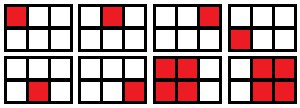2438: Spongebob and Squares
Description
Spongebob is already tired trying to reason his weird actions and calculations, so he simply asked you to find all pairs of n and m, such that there are exactly x distinct squares in the table consisting of n rows and m columns. For example, in a 3×5 table there are 15 squares with side one, 8 squares with side two and 3 squares with side three. The total number of distinct squares in a 3×5 table is 15+8+3=26.
The first line of the input contains a single integer x (1≤x≤1018)− the number of squares inside the tables Spongebob is interested in.
First print a single integer k− the number of tables with exactly x distinct squares inside.
Then print k pairs of integers describing the tables. Print the pairs in the order of increasing n, and in case of equality− in the order of increasing m.
26
6
1 26
2 9
3 5
5 3
9 2
26 1
2
2
1 2
2 1
8
4
1 8
2 3
3 2
8 1
In a 1×2 table there are 2 1×1 squares. So, 2 distinct squares in total.

In a 2×3 table there are 6 1×1 squares and 2 2×2 squares. That is equal to 8 squares in total.
